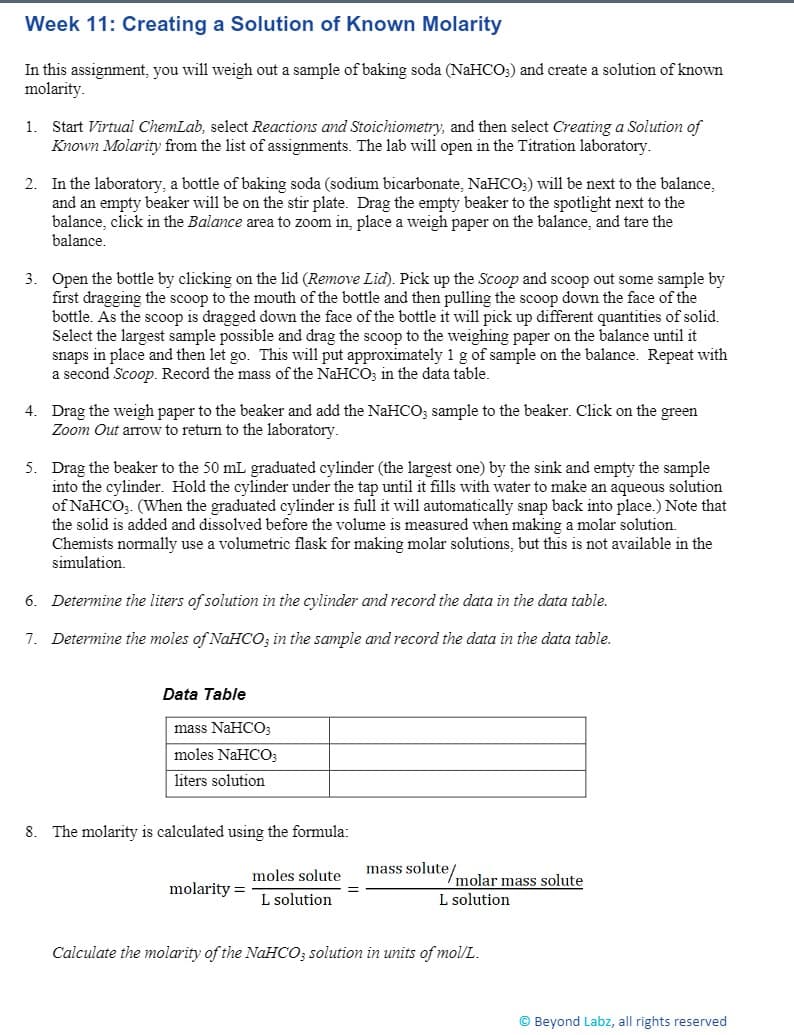Determine the liters of solution in the cylinder and record the data in the data table. Determine the moles of NaHCO; in the sample and record the data in the data table. Data Table mass NaHCO; moles NaHCO; liters solution The molarity is calculated using the formula: moles solute mass solute/ molarity = molar mass solute L solution L solution Calculate the molarity of the NaHCO; solution in units of mol/L.
Determine the liters of solution in the cylinder and record the data in the data table. Determine the moles of NaHCO; in the sample and record the data in the data table. Data Table mass NaHCO; moles NaHCO; liters solution The molarity is calculated using the formula: moles solute mass solute/ molarity = molar mass solute L solution L solution Calculate the molarity of the NaHCO; solution in units of mol/L.
Chapter79: Solubility
Section: Chapter Questions
Problem 1P
Related questions
Question
100%

Transcribed Image Text:Week 11: Creating a Solution of Known Molarity
In this assignment, you will weigh out a sample of baking soda (NAHCO;) and create a solution of known
molarity.
Start Virtual ChemLab, select Reactions and Stoichiometry, and then select Creating a Solution of
Known Molarity from the list of assignments. The lab will open in the Titration laboratory.
1.
2. In the laboratory, a bottle of baking soda (sodium bicarbonate, NaHCO;) will be next to the balance,
and an empty beaker will be on the stir plate. Drag the empty beaker to the spotlight next to the
balance, click in the Balance area to zoom in, place a weigh paper on the balance, and tare the
balance.
3. Open the bottle by clicking on the lid (Remove Lid). Pick up the Scoop and scoop out some sample by
first dragging the scoop to the mouth of the bottle and then pulling the scoop down the face of the
bottle. As the scoop is dragged down the face of the bottle it will pick up different quantities of solid.
Select the largest sample possible and drag the scoop to the weighing paper on the balance until it
snaps in place and then let go. This will put approximately 1 g of sample on the balance. Repeat with
a second Scoop. Record the mass of the NaHCO; in the data table.
4. Drag the weigh paper to the beaker and add the NaHCO; sample to the beaker. Click on the green
Zoom Out arrow to return to the laboratory.
5. Drag the beaker to the 50 mL graduated cylinder (the largest one) by the sink and empty the sample
into the cylinder. Hold the cylinder under the tap until it fills with water to make an aqueous solution
of NaHCO;. (When the graduated cylinder is full it will automatically snap back into place.) Note that
the solid is added and dissolved before the volume is measured when making a molar solution.
Chemists normally use a volumetric flask for making molar solutions, but this is not available in the
simulation.
6. Determine the liters of solution in the cylinder and record the data in the data table.
7. Determine the moles of NaHCO, in the sample and record the data in the data table.
Data Table
mass NaHCO;
moles NaHCO;
liters solution
8. The molarity is calculated using the formula:
moles solute
mass solute/molar mass solute
molarity =
L solution
L solution
Calculate the molarity of the NAHCO; solution in units of mol/L.
© Beyond Labz, all rights reserved
Expert Solution
This question has been solved!
Explore an expertly crafted, step-by-step solution for a thorough understanding of key concepts.
This is a popular solution!
Trending now
This is a popular solution!
Step by step
Solved in 2 steps

Knowledge Booster
Learn more about
Need a deep-dive on the concept behind this application? Look no further. Learn more about this topic, chemistry and related others by exploring similar questions and additional content below.Recommended textbooks for you

EBK A SMALL SCALE APPROACH TO ORGANIC L
Chemistry
ISBN:
9781305446021
Author:
Lampman
Publisher:
CENGAGE LEARNING - CONSIGNMENT

Introductory Chemistry: An Active Learning Approa…
Chemistry
ISBN:
9781305079250
Author:
Mark S. Cracolice, Ed Peters
Publisher:
Cengage Learning

EBK A SMALL SCALE APPROACH TO ORGANIC L
Chemistry
ISBN:
9781305446021
Author:
Lampman
Publisher:
CENGAGE LEARNING - CONSIGNMENT

Introductory Chemistry: An Active Learning Approa…
Chemistry
ISBN:
9781305079250
Author:
Mark S. Cracolice, Ed Peters
Publisher:
Cengage Learning